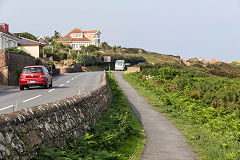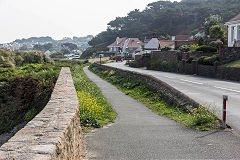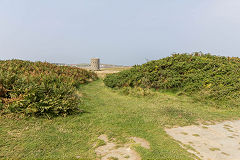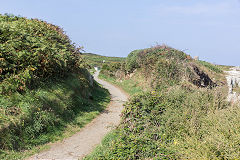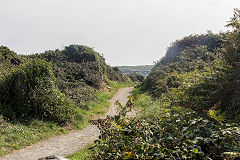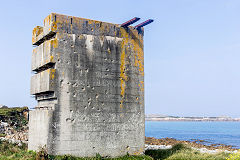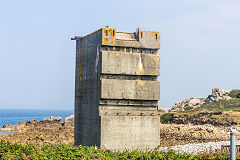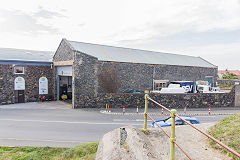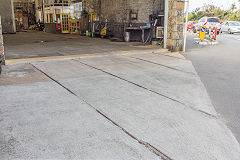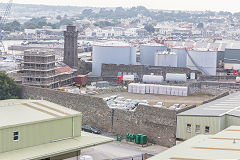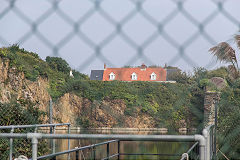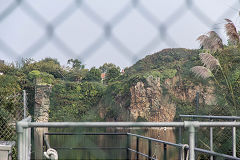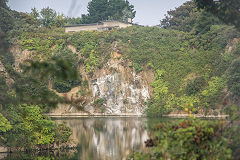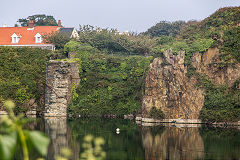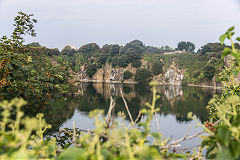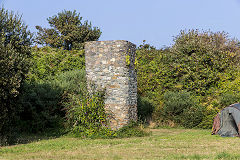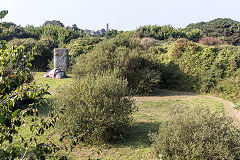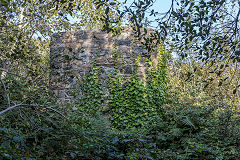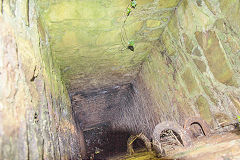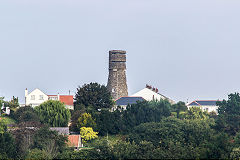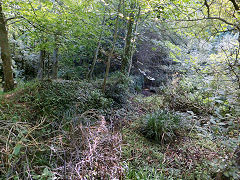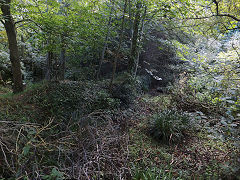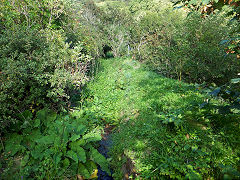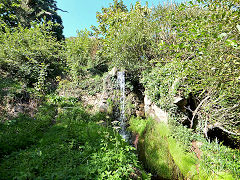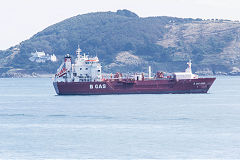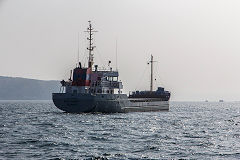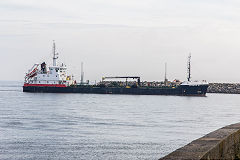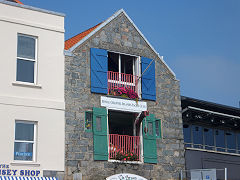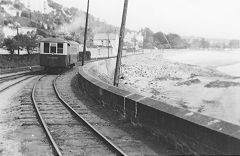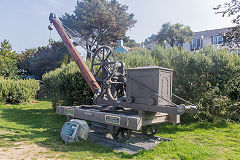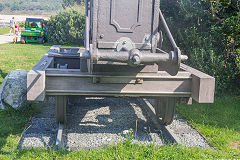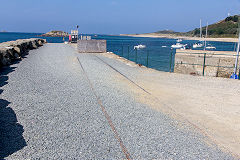Guernsey's fortifications
Clarence Battery, St Peter Port
Built after 1779 and originally known as Terres Point Battery. The orginal buildings and German WW2 ironmongery seem to mix together easily.
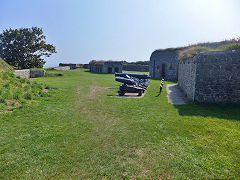
Clarence Battery, Guernsey
|

Clarence Battery, Guernsey
|
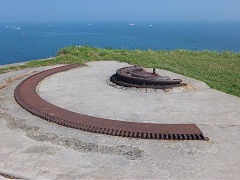
Clarence Battery, Guernsey
|
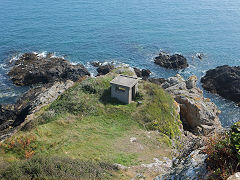
Clarence Battery, Guernsey
|
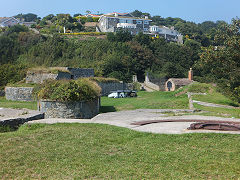
Clarence Battery, Guernsey
|

Clarence Battery traverse
|
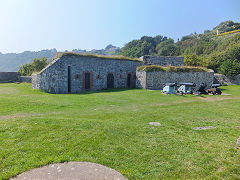
Clarence Battery magazine
|
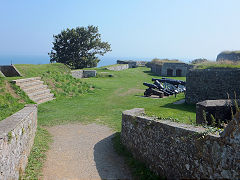
Clarence Battery, Guernsey
|
St Clair Battery and smugglers path
St Clair Battery is a small battery at Petit Bot Bay but with an added extra of a zig-zag smugglers track leading down to a very obscure landing point amongst the rocks.
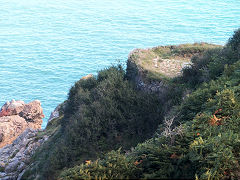
St Clair Battery, Guernsey
|
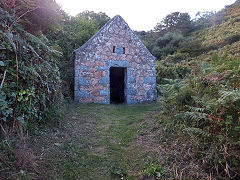
St Clair Battery, Guernsey
|
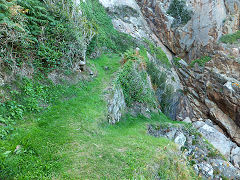
St Clair smugglers path, Guernsey
|
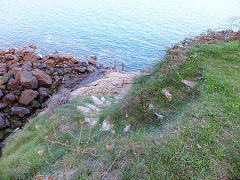
St Clair smugglers path, Guernsey
|
Dollmann Battery and Pleinmont observation towers
The Dollmann battery had four French 22cm guns from WW1 with a range of 22Km backed up by field and machine guns, mortars and searchlights. There are two observation and command posts for direction and range-finging, designated 'MP3' and 'MP4', along with a network of trenches between many accommodation and stores bunkers.
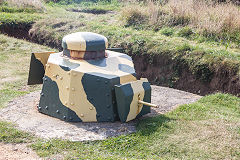
Dollmann Battery, Guernsey
|
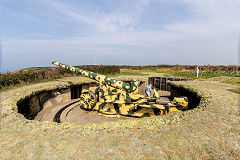
Dollmann Battery 22cm gun
|

Dollmann Battery 22cm gun
|
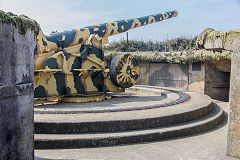
Dollmann Battery 22cm gun
|
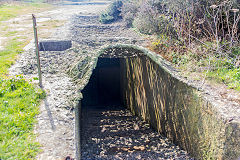
Dollmann Battery, Guernsey
|
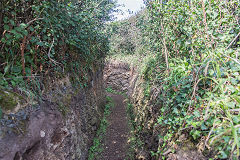
Dollmann Battery, Guernsey
|
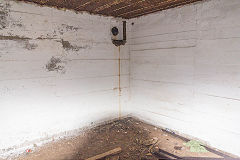
Dollmann Battery, Guernsey
|

Dollmann Battery, Guernsey
|
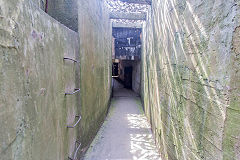
Dollmann Battery, Guernsey
|

Dollmann Battery, Guernsey
|
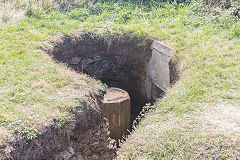
Dollmann Battery, Guernsey
|
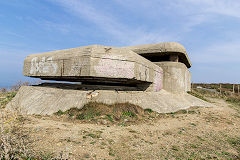
Dollmann Battery observation post
|
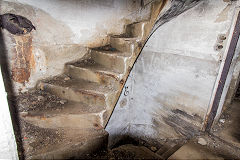
Dollmann Battery observation post
|

Dollmann Battery observation post
|
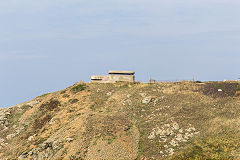
Dollmann Battery observation post
|
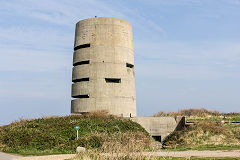
Dollmann Battery obs post 'MP3'
|

Dollmann Battery Obs Post 'MP4'
|
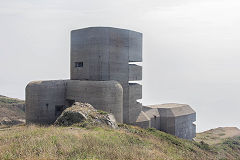
Dollmann Battery Obs Post 'MP4'
|
|
|
Fort Pezeries and Saumarez Observation Tower
Fort Pezeries was a defensive position by 1680 but in disrepair by 1842. The Germans used the Western wall as a machine gun position. The Saumarez obersevation tower began life as a Martello tower in 1804 and the Germans enhanced it with loads of concrete. There is a trench system and small bunkers in front of it.
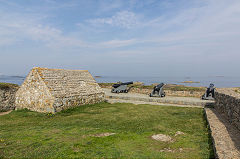
Fort Pezeries magazine, Guernsey
|
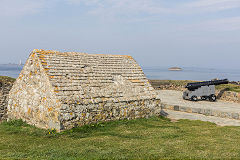
Fort Pezeries magazine, Guernsey
|
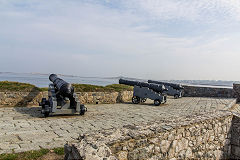
Fort Pezeries, Guernsey
|
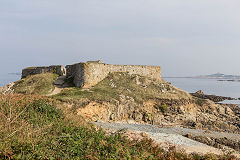
Fort Pezeries, Guernsey
|
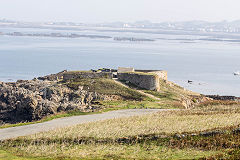
Fort Pezeries, Guernsey
|

Fort Pezeries tunnel, Guernsey
|
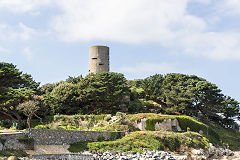
Saumarez observation tower
|
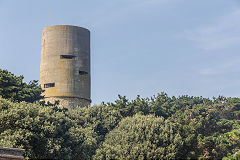
Saumarez observation tower
|
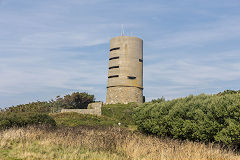
Saumarez observation tower
|
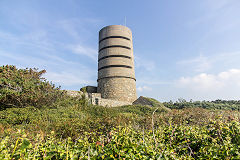
Saumarez observation tower
|
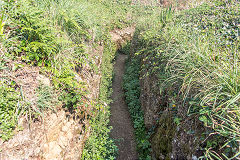
Saumarez trench system
|
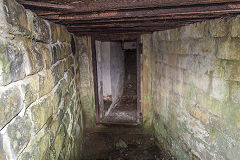
Saumarez trench system
|
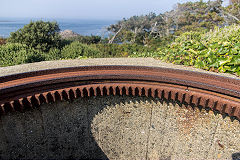
Saumarez trench system
|

Saumarez trench system
|
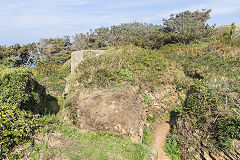
Saumarez trench system
|
|
Fort Hommet
Fort Hommet was originally part of the Napoleonic defenses but much modified by the Germans. They built four 105mm coastal defense gun casemates, one of which has been restored. There was an M19 mortar bunker and a rail-mounted searchlight installation, now the home to the shell shrine.
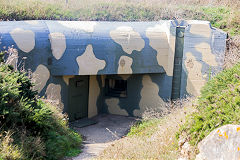
The restored casemate entrance
|
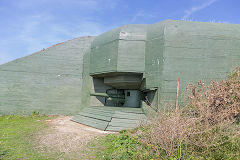
The 105mm coastal defense gun
|
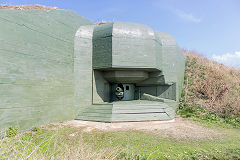
The 105mm coastal defense gun
|
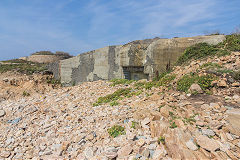
The other 105mm casemates
|
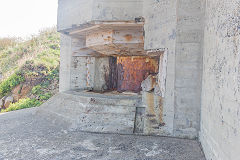
The other 105mm casemates
|
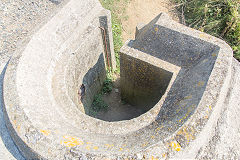
The other 105mm casemates
|
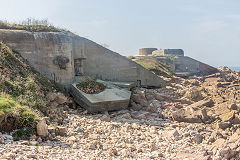
The other 105mm casemates
|
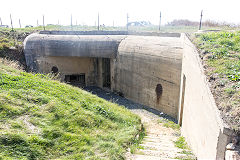
The M19 mortar bunker
|
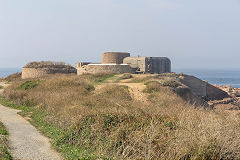
Fort Hommet, Guernsey
|
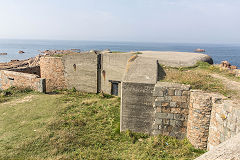
The searchlight bunker
|
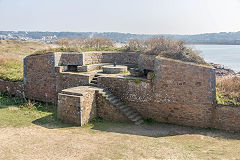
Fort Hommet, Guernsey
|

Fort Hommet, Guernsey
|
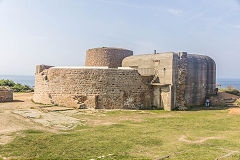
Fort Hommet, Guernsey
|
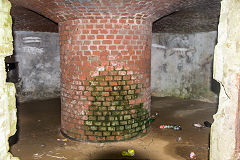
Underneath Fort Hommet
|
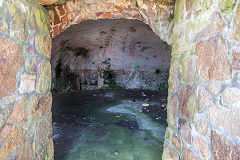
Underneath Fort Hommet
|
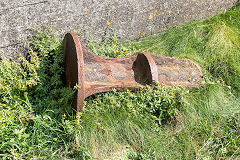
Ironmongery, a gun support?
|
Fort Le Marchant and some unusual shelters
Originally built as Fort L'Angle in 1680, Fort Le Marchant was greatly expanded in the 1790s. In the 1860s a large barracks was built on the landward side behind a dry moat but this was demolished and infilled in 1971.
To the south of the fort are these stone shelters, lined at one time with thick iron sheets. They are open to the sea-side with a stone platform behind them. Were these part of an early firing range?
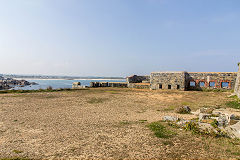
Fort Le Marchant, Guernsey
|
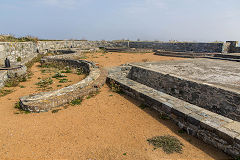
Fort Le Marchant, Guernsey
|
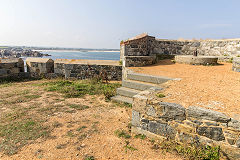
Fort Le Marchant, Guernsey
|
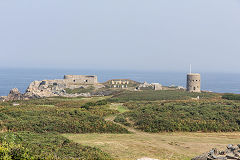
Fort Le Marchant, Guernsey
|
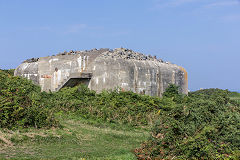
Fort Le Marchant, Guernsey
|

Fort Le Marchant, Guernsey
|
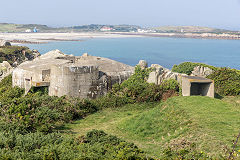
Fort Le Marchant, Guernsey
|

L'Ancresse Bay, Guernsey
|
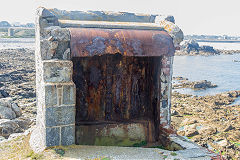
La Fontenelle, Guernsey
|
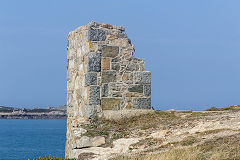
La Fontenelle, Guernsey
|
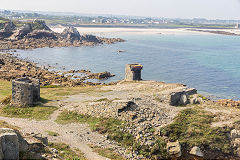
La Fontenelle, Guernsey
|

La Fontenelle magazine, Guernsey
|
Other Forts and Batteries
Fort Doyle, Fort Pembroke, Vale Castle and Rousse, Grandes Rocques and La Moye Batteries. But first, the workings of the rifle range targets at Fort Le Marchant.
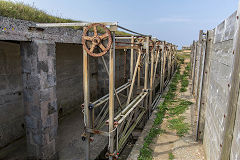
Fort Le Marchant range targets
|
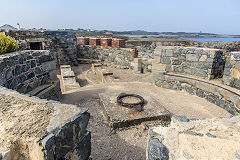
Fort Doyle, Guernsey
|
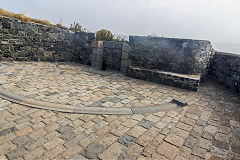
Fort Doyle, Guernsey
|
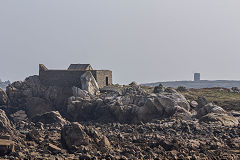
Fort Pembroke, Guernsey
|
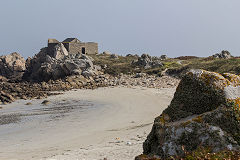
Fort Pembroke, Guernsey
|
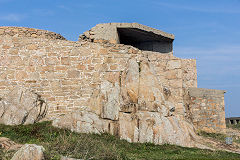
Grandes Rocques battery
|
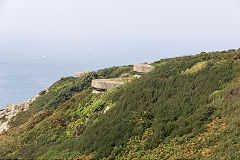
La Moye battery, Guernsey
|
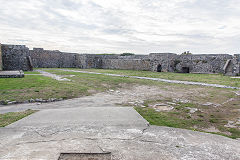
Vale Castle, Guernsey
|
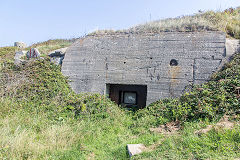
Rousse Battery, Guernsey
|
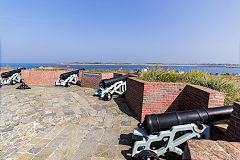
Rousse Battery, Guernsey
|
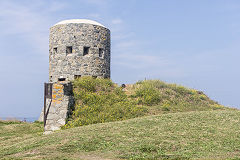
Rousse Battery, Guernsey
|
|
Sark
Maseline Harbour and the windmill

Sark Harbour
|
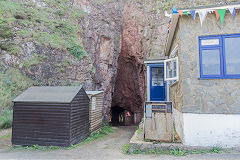
Sark Harbour
|
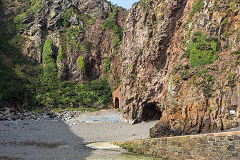
Sark Harbour
|
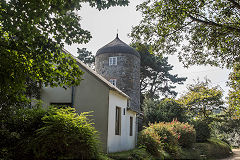
Sark Mill
|
This is the day-to-day working quarry for Sark.
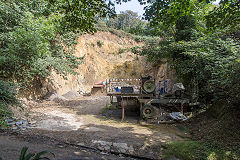
Sark Quarry
|
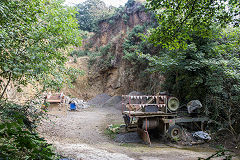
Sark Quarry
|
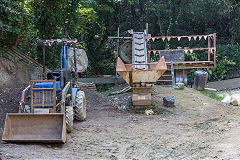
Sark Quarry
|
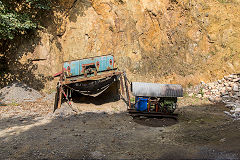
Sark Quarry
|
Little Sark Silver Mine
The silver mines operated from 1835 to 1847. As with so many mining ventures, they were quite prosperous initially but soon the costs began to mount as the silver ore was running out. A fuller account of the history of the mines is at the foot of the page.
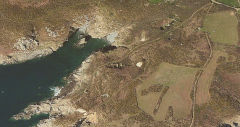
Aerial view of the workings
|
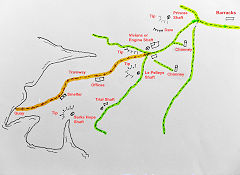
Map of the Sark silver mines
|
|
|
The shafts and waste tips
Le Pelley's Shaft is below the chimneys. The Engine Shaft at the engine house was too overgrown to take a worthwhile photo. Two waste tips are visible, from Le Pelley's Shaft and Engine Shaft but there are others around Sark's Hope Shaft, probably less visible in the very dense undergrowth.
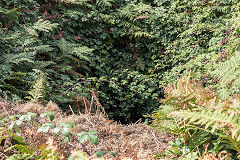
Le Pelley's Shaft
|

Le Pelley's shaft tip
|
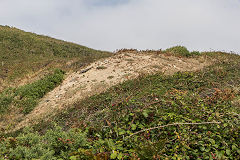
Engine Shaft tip
|
|
The two chimneys
showing the flue access point from the engine house.
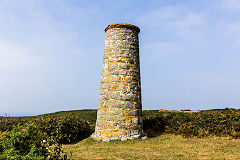
The Northern chimney
|
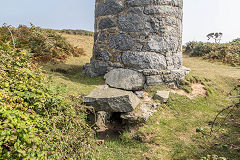
The flue access
|
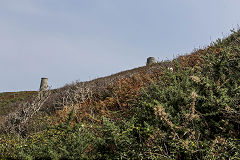
Two chimneys
|
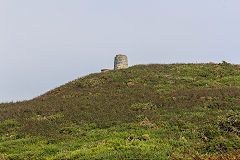
The Southern chimney
|
The Engine House Site
The engine house is to the right of the track down to Port Gorey. Vivian's or Engine Shaft is next to it but very overgrown. There are passageways under the site which appear to have been under the winding engine and boiler house. On the other side of the track there are foundations of buildings that could have been the dressing plant with a short tunnel or passage and what appears to be a low bunker but could be the lower end of the flue to the Southern chimney. Sadly the main landmark, the corner of the engine house, was lost in the storms of Spring 2014.
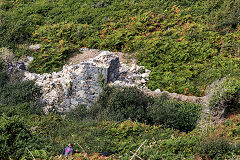
The remains of the engine house
|
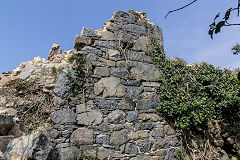
The remains of the engine house
|

The remains of the engine house
|
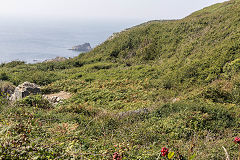
The remains of the engine house
|
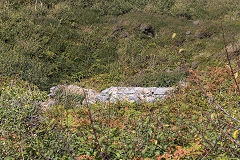
Behind the engine house
|
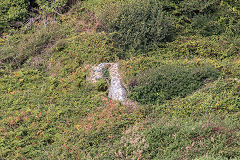
Behind the engine house
|
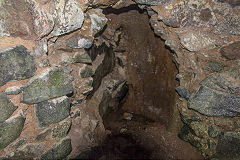
Winding House passageways
|

Winding House passageways
|
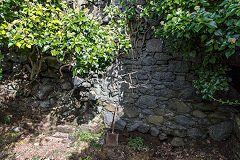
The winding and boiler house
|
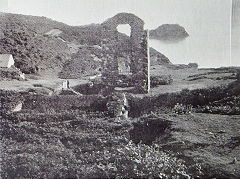
The engine house and pump shaft.
|
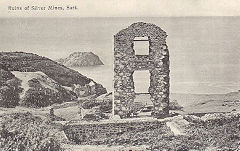
The engine house and pump shaft.
|

The engine house and pump shaft.
|
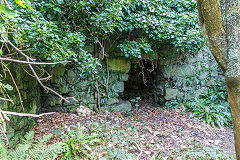
The Dressing Plant
|
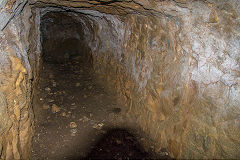
The Dressing Plant tunnel
|
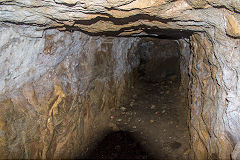
The Dressing Plant tunnel
|
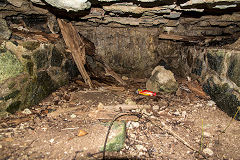
The bunker or flue
|
The Middle site - the offices and workshops
Further down on the left of the track towards Port Gorey there are walls and foundations of the assay and Captain's office, a sawpit and a forge. Behind the complex a short adit is hidden in the jungle.
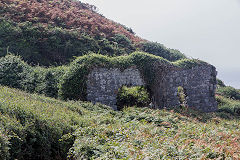
The offices and workshops
|
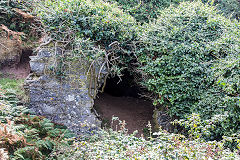
The offices and workshops
|
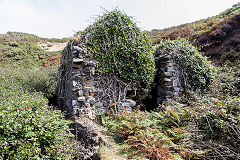
The offices and workshops
|
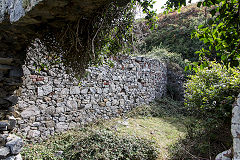
The offices and workshops
|
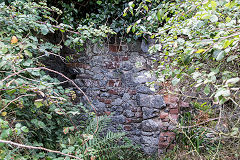
The offices and workshops
|
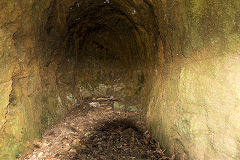
Short level behind the workshops
|
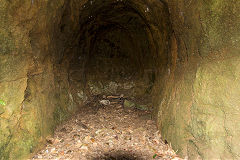
Short level behind the workshops
|
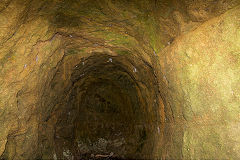
Short level behind the workshops
|
The Lower site - the smelter and stockpile area
The solid-looking building at Port Gorey was the ore smelter which is next to a flat, embanked area, probably the ore stockpile. A narrow gauge railway ran down to the quayside from the engine house area. Aerial photos show more foundations above this site which are believed to be a trial shaft and possibly a treadwheel.
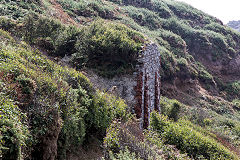
The Port Gorey smelter
|
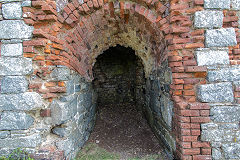
The Port Gorey smelter
|
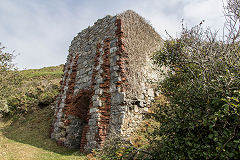
The Port Gorey smelter
|
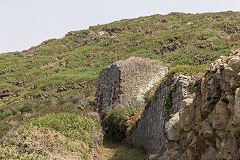
The Port Gorey smelter
|
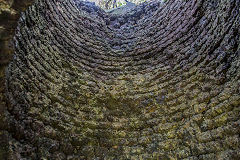
Inside the Port Gorey smelter
|
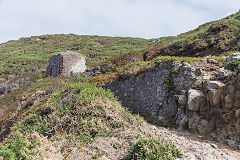
Smelter and ore stockpile
|
|
|
The history of the Sark silver mines
When Queen Elizabeth I granted Helier de Carteret the right to settle Sark in 1565, she conferred on him the 'Droit de Seigneur' which included the rights to minerals and mining.
Since Roman times there has always been the knowledge that many different minerals could bee found on Sark. This is due to the ice age which left Sark with rich mineral deposits exposed on the surface which would have attractedpeople in the Bronze Age and possibly as far back as the Neolithic.
In 1833 a visiting mining engineer, John Hunt, found traces of copper at Creux a Pot. The following year the Seigneur at the time, Pierre Le Pelley,was persuaded to grant a 21 year concession to mine Sark and Brecqhou. The newly-formed Sark and Guernsey Mining Co was floated with 200 £5.00 shares - Hunt bought 30 shares, Le Pelley took up 10 shares.
During the spring of 1835 the first tin mineworkers (accompanied by their women and children) arrived, brought from Cornwall by John Hunt. A few were quartered in Little Sark in a row of six cottages, known today as 'the Barracks', a 19th century Cornish term for accommodation on a mine site.
The 1837 records show that many cottages were being built at the time to house an influx of workers and their families. The 1841 census showed 31 dwellings and 172 people on Little Sark, with a few Cornish mineworkers most of the Sarkese who worked on the mine living on the main part of Sark. It is estimated that the mine employed at least 75 people.
In 1836 a man out shooting rabbits for his supper picked up a lump of silver-lead ore when he went to retrieve his rabbit near Pot Bay.
This was thought to signify a good site for mining so accordingly the Cornish mineworkers and 70 or 80 Sarkese started work at Pot Bay.
Le Pot mine was not viable so it was abandoned and another venture was started at Port es Saies. The men had to be lowered down a cliff face to the Port es Saies mine which proved very wet and, since there were no finances available to provide an engine big enough to keep it clear of water, it too was abandoned.
Mining was the concentrated on Port Gorey. Captain John Prince, an experienced man, was placed in charge. A 240 horsepower steam pumping engine with a 60 inch cylinder was imported and installed requiring a 5 ft wall to support its beam; later an 18 horsepower steam horizontal engine was added for clearing out the lower levels of ore and waste rock. Incidentally the engine that have been required to keep the Port es Saies mine clear of water would have needed an 80 inch cylinder, needing an 8 ft thick supporting wall for its beam.
Four shafts were sunk at Port Gorey - Le Pelley's (close to the path leading to Sark's Hope Shaft), the engine shaft aka Vivian's Shaft after consultant Capt. Nicholas Vivian (just south of the engine house), Prince's Shaft (just south of the road to the Barracks) and Sark's Hope Shaft (due south near the cliff edge) - going as deep as 180 metres, 120 metres below water level.
A narrow gauge railway operated by a manual winch, and a jetty were built in order to load up the ships that were to take the silver that was going to make Sark, and its Seigneur, rich.
A rich seam of silver was struck (then worth £600 per ton) but it was very narrow. A silver tea and coffee service, reputedly made from the Sark silver, was put on public display in the Sark and Guernsey Mining Co's head office in Commercial Arcade, St Peter Port in order to keep the interest of the shareholders high.
Then in 1839 Pierre Le Pelley was drowned at sea off Bec du Nez in the north during a terrible storm. This was witnessed by his good friend Rev Cachemaille who was so traumatised that he never set foot on Sark again.
His brother, Ernest, took over the Fief of Sark as Siegneur, inheriting Pierre's shareholding in the silver mine and making further investments in it.
The period of 1840-41 was a period of great prosperity for the mines and some of the money generated was used to build a new school for educating girls (now the visitor centre). This started as an idea that Pierre had discussed with his friend Cachemaille before his death and the school was completed by Ernest.
The four shafts led to eight galleries, including one that extended 30feet under the sea (the ceiling was so thin that during storms the miners could hear boulders being rolled around above their heads). The ore raised contained very little silver, veins that started well dwindled away, and there was the ever-present need for more money as new pumps were required to prevent flooding.
By using the Fief of Sark as security with Royal Assent Ernest Le Pelley was able to raise a further £4000 from prosperous Guernseyman Jean Allaire (who had reputedly obtained his wealth as a privateer during the Napoleonic Wars). In an effort to increase productivity Le Pelley introduced piece work - but the vein of silver was running out.
Finally, in 1845 (so the story goes) a gallery ceiling collapsed and seawater flooded in drowning ten mineworkers. To add to the disaster the flooded gallery was the only one that was profitable. Legend has it that on the same day a ship loaded with Sark silver was wrecked off the coast of Guernsey by a young captain who diverted from his original route to see his young wife who had just given birth. Everything, crew and uninsured cargo (then worth between £10,000 and £12,000) was lost, although no records exist of such a wreck.
The huge debts, the flooded gallery and finally the loss of the silver ore saw the finish of the ill-fated enterprise.
Le Pelley and many of the shareholders were ruined, more than £30,000 had been spent, most of the miners went back to Cornwall and by 1847 the mine workings were abandoned. All that remains today are two ventilation chimneys and a corner of the engine shaft next to the foundations of the engine house and the assay office. Prince's Shaft is now filled with waste and the other shafts have collapsed.
Two years later Ernest Le Pelley died aged forty-seven. His son, Peter Carey Le Pelley aged 18 and away in the Indian Ocean was unable to buy back the Fief of Sark at the agreed price of £6000.
In 1852 Marie Collins, widow of Thomas Guerin Collins and daughter of Jean Allaire (the Guernseyman who lent Le Pelley £4000), foreclosed on the Fief with the Crown's permission, ending 120 years of Le Pelley leadership.
After debts of £4679 had been deducted Marie Collins became Dame of Sark for less than £1400.



